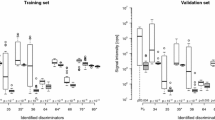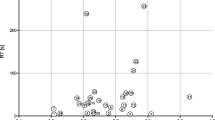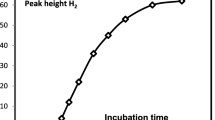Abstract
Outcome of patients with blood stream infections (BSI) depends on the rapid initiation of adequate antibiotic therapy, which relies on the fast and reliable identification of the underlying pathogen. Blood cultures (BC) using CO2-sensitive colorimetric indicators and subsequent microbiological culturing are the diagnostic gold standard but turnaround times range between 24 and 48 h. The detection of volatile organic compounds of microbial origin (mVOC) has been described as a feasible method for identifying microbial growth and to differentiate between several microbial species. In this study, we aimed to investigate the ability of mVOC analyses using a gas chromatograph coupled to an ion mobility spectrometer (GC-IMS) for the recognition of bacterial growth and bacterial differentiation in BCs. Therefore, samples of whole blood and diluted bacterial suspension were injected into aerobic and anaerobic BC bottles and incubated for 8 h. Headspace samples from cultures of Escherichia coli (DSM 25944), Staphylococcus aureus (DSM 13661), and Pseudomonas aeruginosa (DSM 1117) were investigated hourly and we determined at which point of time a differentiation between the bacteria was possible. We found specific mVOC signals in the headspace over growing BCs of all three bacterial species. GC-IMS headspace analyses allowed faster recognition of bacterial growth than the colorimetric indicator of the BCs. A differentiation between the three investigated species was possible after 6 h of incubation with a high reliability in the principal component analysis. We concluded that GC-IMS headspace analyses could be a helpful method for the rapid detection and identification of bacteria in BSI.






Similar content being viewed by others
References
Andrade SS, Bispo PJ, Gales AC (2008) Advances in the microbiological diagnosis of sepsis. Shock 30(Suppl 1):41–46. https://doi.org/10.1097/SHK.0b013e3181819f6c
Avolio M, Diamante P, Modolo ML, De Rosa R, Stano P, Camporese A (2014) Direct molecular detection of pathogens in blood as specific rule-in diagnostic biomarker in patients with presumed sepsis: our experience on a heterogeneous cohort of patients with signs of infective systemic inflammatory response syndrome. Shock 42(2):86–92. https://doi.org/10.1097/shk.0000000000000191
Bunge M, Araghipour N, Mikoviny T, Dunkl J, Schnitzhofer R, Hansel A, Schinner F, Wisthaler A, Margesin R, Märk TD (2008) On-Line Monitoring of Microbial Volatile Metabolites by Proton Transfer Reaction-Mass Spectrometry Appl. Environ. Microbiol 74(7):2179–86. https://doi.org/10.1128/AEM.02069-07
Chen J, Tang J, Shi H, Tang C, Zhang R (2017) Characteristics of colatile organic compounds produced from five pathogenic bacterua by headspace-solid phase micro-extraction/gas chromatography-mass spectrometry. J. Basic Microbiol 57:228–237. https://doi.org/10.1002/jobm.201600505
Chouinard CD, Wei MS, Beekman CR, Kemperman RH, Yost RA (2016) Ion mobility in clinical analysis: current progress and future perspectives. Clin Chem 62(1):124–133. https://doi.org/10.1373/clinchem.2015.238840
Cumeras R, Figueras E, Davis CE, Baumbach JI, Gràcia I (2015) Review on Ion Mobility Spectrometry. Part 1: current instrumentation. Analyst 140(5):1376–1390. https://doi.org/10.1039/C4AN01100G
Effmert U, Kalderas J, Warnke R, Piechulla B (2012) Volatile mediated interactions between bacteria and fungi in the soil. J Chem Ecol 38(6):665–703. https://doi.org/10.1007/s10886-012-0135-5
Eiceman GA, Karpas Z, Hill HH Jr (2013) Ion mobility spectrometry. CRC press
Goff DA, Jankowski C, Tenover FC (2012) Using rapid diagnostic tests to optimize antimicrobial selection in antimicrobial stewardship programs. Pharmacotherapy 32(8):677–87. https://doi.org/10.1002/j.1875-9114.2012.01137.x
Hettinga KA, van Valenberg HJ, Lam TJ, van Hooijdonk AC (2008) Detection of mastitis pathogens by analysis of volatile bacterial metabolites. J. Dairy Sci 91(10):3834–9. https://doi.org/10.3168/jds.2007-0941
Junger M, Vautz W, Kuhns M, Hofmann L, Ulbricht S, Baumbach JI, Quintel M, Perl T (2012) Ion mobility spectrometry for microbial volatile organic compounds: a new identification tool for human pathogenic bacteria. Appl Microbiol Biotechnol 93(6):2603–2614. https://doi.org/10.1007/s00253-012-3924-4
Koczulla R, Hattesohl A, Schmid S, Bödeker B, Maddula S, Baumbach JI (2011) MCC/IMS as potential noninvasive technique in the diagnosis of patients with COPD with and without alpha 1-antitrypsin deficiency. Int J Ion Mobil Spectrom 14(4):177–185. https://doi.org/10.1007/s12127-011-0070-0
Kunze N, Göpel J, Kuhns M, Jünger M, Quintel M, Perl T (2013) Detection and validation of volatile metabolic patterns over different strains of two human pathogenic bacteria during their growth in a complex medium using multi-capillary column-ion mobility spectrometry (MCC-IMS). Appl Microbiol Biotechnol 97:3665–76.
Laupland KB (2013) Incidence of bloodstream infection: a review of population-based studies. Clin Microbiol Infect 19(6):492–500. https://doi.org/10.1111/1469-0691.12144
Lawal O, Muhamadali H, Ahmed WM, White IR, Nijsen TME, Goodacre R, Fowler SJ (2018) Headspace volatile organic compoundsfrom bacteria implicated in ventilator-associated pneumonia analysed by TD-GC/MS. J. Breath Res 12(2):026002. https://doi.org/10.1088/1752-7163/aa8e
Lemfack MC, Gohlke B-O, Toguem SMT, Preissner S, Piechulla B, Preissner R (2018) mVOC 2.0: a database of microbial volatiles. Nucleic Acids Res 46(D1):D1261–D1265. https://doi.org/10.1093/nar/gkx1016
Perl T, Jünger M, Vautz W, Nolte J, Kuhns M, Borg-von Zepelin M, Quintel M (2011) Detection of characteristic metabolites of Aspergillus fumigatus and Candida species using ion mobility spectrometry–metabolic profiling by volatile organic compounds. Mycoses 54(6):e828–e837. https://doi.org/10.1111/j.1439-0507.2011.02037.x
Schulz S, Dickschat JS (2007) Bacterial volatiles: the smell of small organisms. Nat Prod Rep 24(4):814–842. https://doi.org/10.1039/b507392h
Singer M, Deutschman CS, Seymour CW, Shankar-Hari M, Annane D, Bauer M, Bellomo R, Bernard GR, Chiche J-D, Coopersmith CM, Hotchkiss RS, Levy MM, Marshall JC, Martin GS, Opal SM, Rubenfeld GD, van der Poll T, Vincent J-L, Angus DC (2016) The Third International Consensus Definitions for Sepsis and Septic Shock (Sepsis-3). JAMA 315(8):801–810. https://doi.org/10.1001/jama.2016.0287
Stevenson LG, Drake SK, Murray PR (2010) Rapid identification of bacteria in positive blood culture broths by matrix-assisted laser desorption ionization-time of flight mass spectrometry. J Clin Microbiol 48(2):444–447. https://doi.org/10.1128/JCM.01541-09
Tabak YP, Vankeepuram L, Ye G, Jeffers K, Gupta V, Murray PR (2018) Blood culture turnaround time in U.S. acute care hospitals and implications for laboratory process optimization. J Clin Microbiol 56(12). https://doi.org/10.1128/JCM.00500-18
Thorn RM, Reynolds DM, Greenman J (2011) Multivariate analysis of bacterial volatile compound profiles for discrimination between selected species and strains in vitro. J. Microbiol. Methods 84(2):258–64. https://doi.org/10.1016/j.mimet.2010.12.001
Thorpe TC, Wilson ML, Turner JE, DiGuiseppi JL, Willert M, Mirrett S, Reller LB (1990) BacT/Alert: an automated colorimetric microbial detection system. J Clin Microbiol 28(7):1608–1612
Umber BJ, Shin HW, Meinardi S, Leu SY, Zaldivar F, Cooper DM, Blake DR (2013) Gas signatures from Escherichia coli and Escherichia coliinoculated human whole blood. Clin. Transl. Med 2:13. https://doi.org/10.1186/2001-1326-2-13
Vautz W, Schmäh M (2009) HovaCAL®—a generator for multi-component humid calibration gases. Int J Ion Mobil Spectrom 12(4):139–147. https://doi.org/10.1007/s12127-009-0030-0
Vautz W, Nolte J, Bufe A, Baumbach JI, Peters M (2010) Analyses of mouse breath with ion mobility spectrometry: a feasibility study. J Appl Physiol (1985) 108(3):697–704. https://doi.org/10.1152/japplphysiol.00658.2009
Vautz W, Baumbach JI, Jung J (2006a) Beer fermentation control using ion mobility spectrometry — results of a pilot study. J Inst Brew 112(2):157–164. https://doi.org/10.1002/j.2050-0416.2006.tb00245.x
Vautz W, Zimmermann D, Hartmann M, Baumbach JI, Nolte J, Jung J (2006b) Ion mobility spectrometry for food quality and safety. Food Addit Contam 23(11):1064–1073. https://doi.org/10.1080/02652030600889590
Vautz W, Nolte J, Fobbe R, Baumbach JI (2009) Breath analysis—performance and potential of ion mobility spectrometry. J Breath Res 3(3):036004. https://doi.org/10.1088/1752-7155/3/3/036004
Warhurst G, Dunn G, Chadwick P, Blackwood B, McAuley D, Perkins GD, McMullan R, Gates S, Bentley A, Young D, Carlson GL, Dark P (2015) Rapid detection of health-care-associated bloodstream infection in critical care using multipathogen real-time polymerase chain reaction technology: a diagnostic accuracy study and systematic review. Health Technol Assess 19(35):1–142. https://doi.org/10.3310/hta19350
Weinstein MP (2003) Blood culture contamination: persisting problems and partial progress. J Clin Microbiol 41(6):2275–2278. https://doi.org/10.1128/jcm.41.6.2275-2278.2003
Westh H, Lisby G, Breysse F, Böddinghaus B, Chomarat M, Gant V, Goglio A, Raglio A, Schuster H, Stuber F, Wissing H, Hoeft A (2009) Multiplex real-time PCR and blood culture for identification of bloodstream pathogens in patients with suspected sepsis. Clin Microbiol Infect 15(6):544–51. https://doi.org/10.1111/j.1469-0691.2009.02736.x.
Acknowledgements
The authors would like to thank Claudia Ottersbach for her dedicated work contributing to this study.
Funding
This work was supported in part of the cooperation project FKZ 13GW0191A-E funded by the German Federal Ministry of Education and Research. Furthermore, the financial support is provided by the Ministerium für Innovation, Wissenschaft und Forschung des Landes Nordrhein-Westfalen
Author information
Authors and Affiliations
Corresponding author
Ethics declarations
Conflict of interest
The authors declare that they have no conflict of interest.
Ethical approval
Studies with human participants or animals were not carried out in the frame of the present study by any of the authors. The blood samples were used in accordance with ethics committee of the University Medical Center Göttingen (approval number 43/2/19).
Additional information
Publisher’s note
Springer Nature remains neutral with regard to jurisdictional claims in published maps and institutional affiliations.
Electronic supplementary material
ESM 1
(PDF 349 kb)
Rights and permissions
About this article
Cite this article
Drees, C., Vautz, W., Liedtke, S. et al. GC-IMS headspace analyses allow early recognition of bacterial growth and rapid pathogen differentiation in standard blood cultures. Appl Microbiol Biotechnol 103, 9091–9101 (2019). https://doi.org/10.1007/s00253-019-10181-x
Received:
Revised:
Accepted:
Published:
Issue Date:
DOI: https://doi.org/10.1007/s00253-019-10181-x




